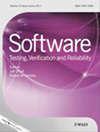Special issue: ISSRE 2018, the 29th IEEE International Symposium on Software Reliability Engineering
IF 1.2
4区 计算机科学
Q3 COMPUTER SCIENCE, SOFTWARE ENGINEERING
引用次数: 0
Abstract
This special issue contains extended versions of five papers from the 29th IEEE International Symposium on Software Reliability Engineering (ISSRE 2018). ISSRE is focused on innovative techniques and tools for assessing, predicting, and improving the reliability, safety, and security of software products. The symposium emphasizes scientific methods, industrial relevance, rigorous empirical validation, and shared value of practical tools and experiences. ISSRE boasts a large industry participation, with authors and participants from international corporations. Based on the reviews from the programme committee members and discussions with the editorsin-chief regarding the relevance of the papers to the journal’s topics of interest, we invited the authors of seven papers to extend their work and submit to this special issue. The extended papers went through several rounds of revision during the rigorous peer-review process. The papers were reviewed by a panel of experts that included, but was not limited to, members of the ISSRE 2018 Program Committee. Five papers successfully completed the review process and are included in this special issue. The first paper, Using Mutants to Help Developers Distinguish and Debug (Compiler) Faults by Josie Holmes and Alex Groce, introduces a distance metric for failing test cases based on the intuition that failing tests that kill the same mutants are likely related to the same fault. This issue is especially relevant for very large test suites, as in the ‘compiler fuzzer taming’ problem. The paper evaluates the metric on two widely used real-world compilers by combining the metric with state-of-the-art methods for fault identification and localization. The second paper, Testing Microservice Architectures for Operational Reliability by Roberto Pietrantuono, Stefano Russo, and Antonio Guerriero, proposes a method for quantitatively assessing the probability of failures (‘operational reliability’) in the context of microservice applications, where the usage profile changes often for reasons such as frequent releases. The method achieves significant improvements in terms of accuracy and efficiency of reliability assessment on three open-source applications. The third paper, Model-based Hypothesis Testing of Uncertain Software Systems by Matteo Camilli, Angelo Gargantini, and Patrizia Scandurra, presents a methodology for combining model-based testing with Bayesian reasoning for testing systems with stochastic QoS properties using a model with uncertain parameters. The paper provides a detailed and reproducible case study for demonstrating the methodology. The fourth paper, Fully Automated HTML and Javascript Rewriting for Constructing a Self-healing Web Proxy by Thomas Durieux, Youssef Hamadi, and Martin Monperrus, applies the failure-oblivious computing principle to web applications. Errors are masked through HTML and Javascript code rewriting (e.g., to skip the faulty line) with an HTTP proxy and a browser extension, respectively. The approach is empirically evaluated on a large, publicly available data set of reproducible Javascript errors. A significant share of errors can be automatically self-healed with this simple strategy. The fifth paper, Facilitating Program Performance Profiling via Evolutionary Symbolic Execution by Andrea Aquino, Pietro Braione, Giovanni Denaro, and Pasquale Salza, pursues performance特刊:ISSRE 2018,第29届IEEE软件可靠性工程国际研讨会
本特刊包含来自第29届IEEE软件可靠性工程国际研讨会(ISSRE 2018)的五篇论文的扩展版本。ISSRE专注于创新技术和工具,用于评估、预测和提高软件产品的可靠性、安全性和安全性。研讨会强调科学方法、工业相关性、严格的实证验证以及实用工具和经验的共享价值。ISSRE拥有庞大的行业参与,作者和参与者来自国际公司。根据计划委员会成员的评论以及与主编就论文与期刊感兴趣的主题的相关性进行的讨论,我们邀请了七篇论文的作者扩展他们的工作并提交给本期特刊。在严格的同行评审过程中,论文经过了几轮修改。这些论文由包括但不限于ISSRE 2018计划委员会成员在内的专家小组进行审查。五篇论文成功地完成了评审过程,并被收录在本期特刊中。第一篇论文,Josie Holmes和Alex Groce撰写的《使用突变体来帮助开发人员区分和调试(编译器)错误》,介绍了一个失败测试用例的距离度量,该度量基于这样一种直觉,即失败的测试杀死相同的突变体可能与相同的错误有关。这个问题与非常大的测试套件特别相关,如“编译器模糊器驯服”问题。本文将该度量与最新的故障识别和定位方法相结合,在两种广泛使用的实际编译器上对该度量进行了评估。第二篇论文,Roberto Pietrantuono、Stefano Russo和Antonio Guerriero撰写的《测试微服务架构的运行可靠性》,提出了一种在微服务应用环境中定量评估故障概率(“运行可靠性”)的方法,在微服务应用环境中,由于频繁发布等原因,使用概况经常发生变化。在三个开源应用中,该方法在可靠性评估的准确性和效率方面取得了显著的提高。第三篇论文,由Matteo Camilli, Angelo Gargantini和Patrizia Scandurra撰写的基于模型的不确定软件系统假设测试,提出了一种将基于模型的测试与贝叶斯推理相结合的方法,用于使用具有不确定参数的模型测试具有随机QoS属性的系统。本文提供了一个详细的和可复制的案例研究来证明该方法。第四篇论文《构建自修复Web代理的全自动HTML和Javascript重写》,作者是Thomas Durieux、Youssef Hamadi和Martin Monperrus,论文将故障无关计算原理应用于Web应用程序。错误是通过HTML和Javascript代码重写来屏蔽的(例如,跳过错误行),分别使用HTTP代理和浏览器扩展。该方法是在大量可重复的Javascript错误的公开可用数据集上进行经验评估的。通过这个简单的策略,大部分错误都可以自动自我修复。第五篇论文,Andrea Aquino, Pietro Braione, Giovanni Denaro和Pasquale Salza通过进化符号执行促进程序性能分析,研究性能
本文章由计算机程序翻译,如有差异,请以英文原文为准。
求助全文
约1分钟内获得全文
求助全文
来源期刊

Software Testing Verification & Reliability
工程技术-计算机:软件工程
CiteScore
3.70
自引率
0.00%
发文量
34
审稿时长
>12 weeks
期刊介绍:
The journal is the premier outlet for research results on the subjects of testing, verification and reliability. Readers will find useful research on issues pertaining to building better software and evaluating it.
The journal is unique in its emphasis on theoretical foundations and applications to real-world software development. The balance of theory, empirical work, and practical applications provide readers with better techniques for testing, verifying and improving the reliability of software.
The journal targets researchers, practitioners, educators and students that have a vested interest in results generated by high-quality testing, verification and reliability modeling and evaluation of software. Topics of special interest include, but are not limited to:
-New criteria for software testing and verification
-Application of existing software testing and verification techniques to new types of software, including web applications, web services, embedded software, aspect-oriented software, and software architectures
-Model based testing
-Formal verification techniques such as model-checking
-Comparison of testing and verification techniques
-Measurement of and metrics for testing, verification and reliability
-Industrial experience with cutting edge techniques
-Descriptions and evaluations of commercial and open-source software testing tools
-Reliability modeling, measurement and application
-Testing and verification of software security
-Automated test data generation
-Process issues and methods
-Non-functional testing
 求助内容:
求助内容: 应助结果提醒方式:
应助结果提醒方式:


